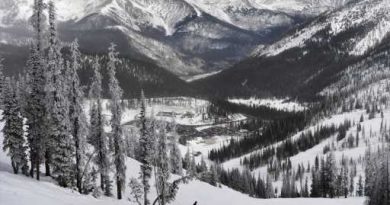Explore Tasmania through these spectacular photos
Welcome to Tasmania
Tasmania, Australia’s spectacular island state, has long been overlooked by international travelers. Those in the know come here for the empty white sand beaches, world class hiking, a superb farm-to-table food scene and a calendar filled with travel-worthy festivals. Explore it on this virtual tour.
Hobart, Tasmania’s capital
Hobart, the capital of Tasmania – and second oldest and smallest capital in Australia – has a lot going on for a city of just over 200,000 people. Head to the waterfront to enjoy seafood pulled straight from the ocean, admire the modern art collection at MONA or soak up the lively atmosphere at the Saturday Salamanca Market.
Mt. Wellington
The 20-minute drive from Hobart to the summit of Mt. Wellington takes visitors through temperate rainforest to the sub-alpine peak. An open viewing platform offers one of the best views in all of Tasmania, overlooking the city of Hobart, Bruny Island and the Tasman Peninsula.
Aurora australis: the southern lights
You may have heard of the northern lights in the Arctic sky. The southern hemisphere has its equivalent, the aurora australis. The southern lights can be spotted year-round in the far south of Tasmania. Like their northern counterpart, the southern lights are caused by a solar wind.
Mt Field National Park
Mount Field National Park, located just an hour outside of Hobart, ranks among Tasmania’s oldest and most accessible national parks. Paths lead through forests and alpine meadows for the chance to see Russell Falls (the park’s most popular attraction) or the world’s tallest flowering plant, the giant swamp gum.
Tamar Valley Wine Region
The Tamar River winds for 37 miles from Launceston to Bass Strait. Many consider the Tamar Valley to be one of Tasmania’s prettiest regions. It’s also the island’s most important wine-producing region, known for its cool-climate vineyards and sparkling wines.
West Coast Wilderness Railway
Train buffs will find the world’s steepest steam-operated railway in Tasmania. The West Coast Wilderness Railway takes passengers on a 10-mile journey through the Tasmanian wildlands aboard the same locomotives once used to move copper ore from Queenstown to the port of Strahan.
Port Arthur Historic Site
Port Arthur’s history dates back to 1830, when it was founded as a timber station. It’s better known, however, as a former penal colony where British criminals were sent in the years from 1833 to 1853. Today, the UNESCO World Heritage site is the most intact convict site in Australia, complete with more than 30 historic buildings.
Tasmanian devil
Wildlife is abundant in Tasmania, but perhaps no animal is quite as iconic to this region as a carnivorous marsupial known as the Tasmanian devil. You can often hear this endangered species at night, when they emerge from their burrows to hunt for insects, birds and small mammals.
It’s rare to spot the critters in the wild, but you can see them at the Bonorong Wildlife Sanctuary.
The Overland Track
Tasmania has some of the best hiking on the planet. One of the most famous alpine hikes is the Overland Track from Cradle Mountain to Lake St. Clair. The 40-mile bushwalking track takes about six days to complete and attracts hikers from around the globe.
Gallery: 25 amazing places for future travel, per National Geographic (USA TODAY)
Three Capes Track
The Tasman Peninsula sets the scene for another of Tasmania’s popular multi-day walks, the Three Capes Track. This 30-mile track is best known for its outlooks along the clifftops of Cape Pillar, Cape Hauy and toward Cape Raoul. The walk typically takes four days to complete.
Maria Island
You’ll have to take a ferry to get to Maria Island, a wildlife sanctuary and national park off the east coast of Tasmania. What the island lacks in amenities, it makes up for in immense natural beauty, from white sand beaches (Ocean Beach pictured) to fern-filled forests. The azure waters off the coast are popular among snorkelers and divers.
Land of lavender
Some of the world’s best lavender oil, known for its relaxing fragrance, comes from the Bridestowe Lavender Estate in the north of Tasmania. Visitors can wander freely through the 260 acres of rolling lavender fields, take a tour to learn about how the oil is extracted, shop for lavender products or sample lavender-infused treats.
Tessellated Pavement
Tasman National Park protects the Tasman Peninsula in southwestern Tasmania. This park is known for its monumental coastal rock formations and towering sea cliffs. Among the highlights is the Tessellated Pavement, a flat rock surface fractured into rectangular shapes.
Queenstown
Queenstown serves as the gateway to Tasmania’s west coast. Queenstown was once one of the world’s richest copper mining towns, and that mining history remains.
Wineglass Bay
Freycinet National Park on the East Coast is one of Tasmania’s best known national parks. The three granite peaks of the Hazards stand watch over the Freycinet Peninsula and the iconic Wineglass Bay with its white sand beach.
Jacob’s Ladder
Ben Lomond National Park protects a stark, treeless alpine plateau – a major skiing destination in winter. A highlight of a visit to the park is the drive to the top of the plateau on Jacob’s Ladder. The series of hairpin turns zig-zagging up the mountain have served as a training ground for Tour de France cyclist Richie Porte.
Cradle Mountain
Cradle Mountain, located within Cradle Mountain-Lake St Clair National Park, is the starting point of the Overland Track and a popular destination on its own. The peak itself is surrounded by glacial lakes and alpine vegetation, all of which can be experienced via a series of short hikes.
Bruny Island Neck
You’ll find one of Tasmania’s most Instagrammed spots on Bruny Island. The Neck is an isthmus of land connecting the north and south parts of the island and offering spectacular 360-degree views from the top. Keep an eye out for little penguins and short-tailed shearwaters.
Cape Bruny Lighthouse
The Cape Bruny Lighthouse, the second oldest extant lighthouse in Australia, rises 374 feet above the southern tip of Bruny Island. Visitors can tour the lighthouse for views over the majestic South Bruny coastline.
The Nut
On the northwest coast of Tasmania, you’ll see a sheer-sided bluff rising above the fishing village of Stanley. This formation, known as the Nut, is a remnant of a volcanic plug. Visitors can walk or ride a chairlift to the top to enjoy the views across Bass Strait.
Glowworm safari
Many of Tasmania’s subterranean cave systems provide a habitat for some mighty magical little creatures: glowworms. These points of glowing blue light aren’t worms at all but hanging larvae of an insect endemic to Australia.
Agritourism
The culinary landscape in Tasmania is rich with local farms and food producers. The island is particularly well known for its cheeses – cheddars, camemberts, blues and bries made from cow, sheep or goat’s milk. Many farms offer farm stays, giving visitors a firsthand look at where their food comes from.
Tasmanian tulips
The end of September brings tulip season to Tasmania. These blooms grow so well in the volcanic soil of the Table Cape, in fact, that some of them are actually exported to the Netherlands. Wander through the flower fields at the Table Cape Tulip Farm or see them in bloom at the Royal Tasmanian Botanical Garden in Hobart.
Mid-winter bash
The Tasmanian calendar is filled with colorful events and festivals, and the Huon Valley Mid-Winter Festival ranks among the most unusual. The tradition is tied to the region’s apple growing history. Locals dress up and go wassailing – an English tradition meant to scare away bad luck and ensure a good apple harvest.
The three-day event includes plenty of food and drink (think cider), as well as an effigy burning.
10Best is a part of the USA TODAY Network, providing an authentically local point of view on destinations around the world, in addition to travel and lifestyle advice.
Source: Read Full Article




